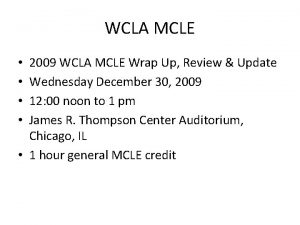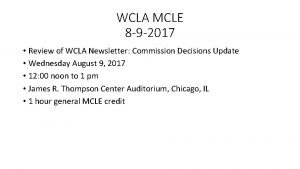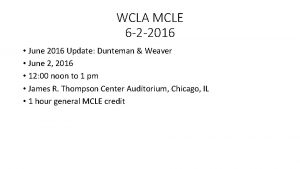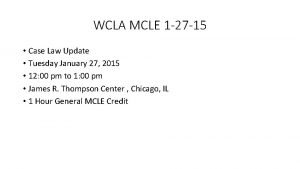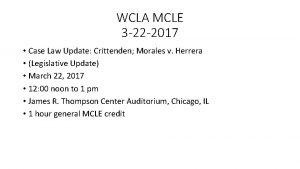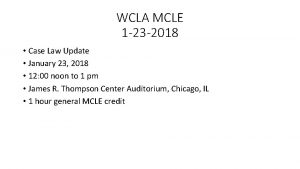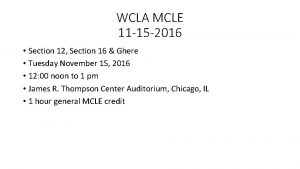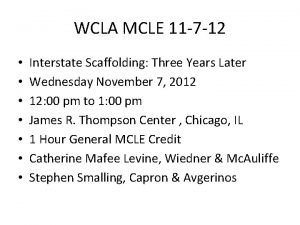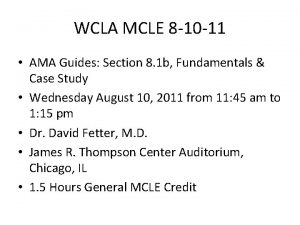WCLA MCLE 12 15 2016 Update from the



















- Slides: 19

WCLA MCLE 12 -15 -2016 • Update from the Chair & Case law Update • Thursday December 15, 2016 • 12: 00 noon to 1 pm • James R. Thompson Center Auditorium, Chicago, IL • 1 hour general MCLE credit

Corn Belt 2016 IL App (3 d) 150311 WC PLA Denied 11/23/2016 • No. 121191 - Corn Belt Energy Corp. , Petitioner, v. The Illinois Workers' Compensation Commission et al. (James Lind, respondent). Leave to appeal, Appellate Court, Third District. (3 -15 -311 WC). • Petition for leave to appeal denied. • Clearly, the plain language of section 8. 1 b places no explicit requirement on either party. Nor does it make the submission of a PPD impairment report a prerequisite to an award of PPD benefits by the Commission. Rather, the section speaks in terms of what factors the Commission is required to consider when determining the appropriate level of PPD. e • Under the Act, a PPD impairment report may be submitted by either party. Further, when one is admitted into evidence, it must be considered by the Commission, along with other identified factors, in determining the claimant's level of PPD. None of the factors set forth in section 8. 1 b is to be the sole determinant of the claimant's disability. Further, nothing in the plain language of the Act precludes a PPD award when no PPD impairment report is submitted by either party. Consequently, we reject this contention by the employer.

Corn Belt v. IWCC 2016 IL App (3 d) 150311 WC • Finally, on appeal, the employer argues the Commission failed to comply with section 8. 1 b(b) by failing to explain the relevance and weight of the factors it used to determine claimant's level of disability. We agree. • That section also provides that "[i]n determining the [claimant's] level of disability, the relevance and weight of any factors used in addition to the level of impairment as reported by the physician must be explained in a written order. “ • IWCC did not explain the relevance or weight it attributed to each factor when determining claimant's level of disability. Thus, we find the Commission failed to comply with section 8. 1 b(b) of the Act. We reverse the Commission's PPD award and remand for compliance with the Act's requirements.

Frederick Williams v. Flexible Staffing 11 WC 046390; 13 IWCC 0557; 13 L 50595; 14 IWCC 0576 Facts & Summary DA 10 -7 -11 45 year old welder grabs for 400 lb rail Right distal biceps tendon rupture Dr. Aribindi performs surgery RTW full duty, despite complaints; no job Dr. Mark Levin does AMA impairment rating: 6% UEI; 4% WPI Arbitrator’s Decision: 30% arm; reduced by IWCC to 25% arm Respondent’s Circuit Court Review: “Remanding-Ord” (2 -13 -14 “Re-Arbitration Allowed”) 14 IWCC 0576: Corrected Decision & Opinion On Remand (7 -22 -14): 25% loss of use of the Right Arm • 8 -15 -14 Respondent files Circuit Court Review • Respondent files Notice of Appeal • 11 -10 -16: Appellate Court Decision • • •

Frederick Williams v. Flexible Staffing 11 WC 046390; 13 IWCC 0557; 13 L 50595; 14 IWCC 0576 “With regards to (i) of Section 8. 1(b) of the Act: ” • The level of impairment reported by Dr. Levin pursuant to the most current edition of the American Medical Association's Guides to the Evaluation of Permanent Impairment is 6% upper extremity impairment and "disability" rating of 4% of a whole person. The Arbitrator notes that impairment does not equate to permanent partial disability under the Workers' Compensation Act. Dr. Levin's reference to "an AMA disability rating" is misplaced; Dr. Levin is rating impairment only, not permanent partial disability. Dr. Levin does not specifically include loss of range of motion or any other measurements that establishes the nature and extent of the impairment pursuant to Section 8. 1 b. Dr. Levin used a physical examination grade modifier of 2 indicating a moderate problem. Dr. Levin did not consider a grade modifier for clinical studies in his impairment report, even though the surgical report could have been used in this way. Dr. Levin scored the QDASH report for functional history grade modifier as 23, however, does not include a copy of the QDASH in his impairment report so that the Arbitrator may review his findings.

Frederick Williams v. Flexible Staffing 11 WC 046390; 13 IWCC 0557; 13 L 50595 Factor (i) Reported Level of Impairment Dr. Levin’s report admitted by stipulation; Identifies himself as CEDIR (AADEP certification) 6% UEI and “disability” of WP 4%; reference to disability is “misplaced; ” “Impairment does not equate to PPD” (Guides, pgs. 5 -6) “Does not include loss of range of motion” or “other measurements” See 8. 1 b(a): “impairment report shall include an evaluation of medically defined and professionally appropriate measurements of impairment that include, but are not limited to: loss of range of motion, loss of stength…” • See asterisk, end of table 15 -4, (Guides, pg. 400): “If motion loss is present, this impairment may alternatively be assessed using Section 15. 7, Range of Motion Impairment. ” • Table 2 -1, Fundamental Principles of the Guides, pg. 20, #12: “If the Guides provides more than one method to rate a particular impairment or condition, the method producing the higher rating must be used. ” • • •

Frederick Williams v. Flexible Staffing 11 WC 046390; 13 IWCC 0557; 13 L 50595 Factor (i) Reported Level of Impairment • DX Elbow Regional Grid, Table 15 -4, pg. 399: CDX 1; Distal biceps tendon rupture; Residual loss of strength, functional with normal motion; default position C is 5% UEI (3, 4, 5, 6, 7) • Physical Exam PE grade modifier 2 because “moderate problem” (Table 15 -8, pg. 408; range of motion moderate decrease; 12%-23% UEI? ); Arbitrator notes: “moderate problem” • Clinical Studies CS grade modifier NA because “diagnosis was biceps tendon rupture; ” probably meant “If a finding is used for placement of a diagnosis within a specific class in a DBI grid, that same finding cannot be used as a grade modifier. ” section 15. 3 c, pg. 407; Arbitrator says “surgical report could have been used in this way” (Table 15 -9, pg. 410; GMCS =2? ) • Functional History FH grade modifier 1 because Quick DASH score 23, Arbitrator notes that it is not included so she cannot “review his findings. ” (Table 15 -7, pg. 406); See Section 2. 7 “Preparing Reports, ” pg. 28 “must be used to document data and be attached with the final report. ” • Net Adjustment = (GMPE-CDX) + (GMCS-CDX) + (GMFH-CDX) = (2 -1) + NA + (1 -1) = 1 + NA + 0 = Net. Adjustment +1 • Move one space to right from default C 5% = 6% UEI x 60% = 4%WPI (Table 15 -11, pg. 420)

Frederick Williams v. Flexible Staffing 11 WC 046390; 13 IWCC 0557; 13 L 50595 Factors (ii) through (iv) • Factor (ii): Occupation of the injured employee • “Arbitrator takes judicial notice to be medium to heavy work; ” therefore, “PPD will be larger than individual who performs lighter work. ” • Factor (iii): Age of Employee at the Time of Injury • 44 yo “somewhat younger individual; ” therefore, “PPD more extensive than that of an older individual because he will have to live with PPD longer. ” • Factor (iv): Employee’s Future Earning Capacity • “Appears to be undiminished…returned to full-time duties…told he no longer had a job…may negatively affect Petitioner’s future earning capacity. ”

Frederick Williams v. Flexible Staffing 11 WC 046390; 13 IWCC 0557; 13 L 50595 Factor (v) Evidence of Disability • Demonstrated evidence of disability corroborated by his treating medical records • Credibly testified • Pain, numbness, tingling and loss of range of motion • Corroborated by treating medical records of Dr. Aribindi • Corroborated by “diagnosis; necessity of surgery; course of treatment” • “Last visit”: loss of range of motion • “Evidences a disability as indicated by commission decisions regarded as precedent pursuant to section 19(e). ”

Frederick Williams v. Flexible Staffing 11 WC 046390; 13 IWCC 0557; 13 L 50595 Determination of PPD • “Not simply a calculation, but an evaluation of all five factors” as stated in 8. 1 b • No sole determinant, not even AMA impairment rating • “Therefore applying section 8. 1 b” PPD is 30% loss of use of the right arm. ” • 13 IWCC 0557: “The Commission modifies the Arbitrator’s decision, decreasing the Petitioner’s permanent partial disability award from 30% to 25% loss of use of the right arm pursuant to Section 8(e) of the Act. All else is affirmed and adopted. ”

Frederick Williams v. Flexible Staffing 14 IWCC 0576 • On remand the Commission makes the following clarification to support its conclusion, modifies the Decision of the Arbitrator as stated below and otherwise affirms and adopts the decision of the Arbitrator. • We understand Respondent's argument that Dr. Levin's A. M. A. impairment rating of 6% of the upper extremity was not given enough weight by the Arbitrator. However, we do not agree with the great weight that Respondent wants placed on this rating because to do so would be to disregard the other factors and give them no weight at all. Section 8. 1 b of the Act requires the consideration of five factors in determining permanent partial disability • Section 8. 1 b also states, "No single factor shall be the sole determinant of disability. In determining the level of disability, the relevance and weight of any factors used in addition to the level of impairment as reported by the physician must be explained in a written order. " We initially note that the term "impairment" in relation to the A. M. A. rating is not synonymous with the term "disability" as it relates to the ultimate permanent partial disability award.

Frederick Williams v. Flexible Staffing 14 IWCC 0576 • Based on the above, the Commission finds that the 6% impairment rating by Dr. Levin does not adequately represent Petitioner's actual disability in this case. When considering the other four factors, we find that Petitioner's permanent partial disability is 25% loss of use of the right arm. The Commission modifies the Arbitrator's Decision, to decrease Petitioner's partial disability award from 30% to 25% loss of use of the right arm pursuant to Section 8(e) of the Act. • Discussion of other factors • Case now pending in Appellate Court: 1 -15 -1300 WC

Issues Presented for Review by Respondent Flexible Staffing v. IWCC & Frederick Williams Appellate Court, 1 -15 -1300 WC • The Act requires evidence in the record for each factor considered in the permanent partial disability determination under Section 8. 1 b. • The 2011 amendments are unambiguous and should be interpreted by their plain language. • The Commission misinterpreted the requirements of Section 8. 1 b when it considered each factor regardless of whethere was any evidence supporting an increased level of disability for each factor. • Alternatively, the Commission’s decision was contrary to the manifest weight of the evidence. • There was no evidence to support consideration of factor (iii) age at the time of injury. • There was no evidence to support consideration of factor (iv) the employee’s future earning capacity. • Disability was unsupported by the treating medical records and could not be considered for factor (v) evidence of disability corroborated by the treating medical records.

Flexible Staffing Services v. IWCC 2106 IL App (1 st) 151300 WC • Respondent contends that the Commission applied the incorrect legal standard in assessing claimant’s claim and that, in any event, its decision is contrary to the manifest weight of the evidence. We disagree and affirm. • Legal standard: Respondent goes on to argue that the Commission misapplied section 8. 1 b as a matter of law because it considered factors for which no evidence was present in the record. For example, it contends that the Commission considered claimant’s age as a factor weighing in favor of a greater degree of disability despite there being no evidence of record regarding the impact of claimant’s age on his disability. • Respondent attempts to frame this issue as the Commission misunderstanding the statute and believing that it could make findings on the factors set forth in section 8. 1 b “regardless of whethere was evidence in the record showing that the factor had an impact on Williams’ level of partial disability. ” As we read the Commission’s decision, it believed it had evidence before it on all of the factors it considered. Thus, what respondent purports to have identified is actually findings by the Commission that allegedly do not find support in the record. This raises a factual question—namely, whether the Commission’s decision is contrary to the manifest weight of the evidence, which brings us to respondent’s second argument.

Flexible Staffing Services v. IWCC 2106 IL App (1 st) 151300 WC • Manifest weight: As explained in the background section of this opinion, the Commission made detailed findings regarding each factor. As this is a factual matter, we will assess respondent’s arguments using the manifest-weight standard and reverse only if an opposite conclusion is clearly apparent. • Contrary to respondent’s claims, there was evidence in the record from which the Commission could draw inferences about claimant’s disability as it relates to his occupation. (“It cannot seriously be disputed that claimant knew what his own job entailed. ”) • That a younger person will probably live longer than an older person is hardly a controversial proposition. The Commission is not required to abandon common sense in rendering its decision. • From this evidence (e. g. Petitioner’s testimony, Respondent did not re-employ him) the Commission could draw inferences about claimant’s future earning capacity, so it cannot be said that the Commission’s decision finds no evidentiary support in the record.

Flexible Staffing Services v. IWCC 2106 IL App (1 st) 151300 WC • It is inferable that claimant is more prone to economic injury following his accident. Moreover, it is worth remembering that the Commission is an administrative body, possessing unique skill and expertise in the areas of medical and workers’ compensation issues. • Hence, we will not take “corroborate” to mean that there must be a point-by-point coincidence between the nonmedical evidence relied upon and the accompanying medical record. Rather, so long as the medical record tends to confirm, strengthen, or make the nonmedical evidence more certain, it provides sufficient corroboration such that the nonmedical evidence may be considered under the fifth factor. • Thus, none of respondent’s contentions regarding the Commission’s findings lacking evidentiary support are well founded. In turn, we reject respondent’s argument that the Commission erred in determining the level of disability as it purportedly could only rely upon the first and, to an extent, the fifth factors. Quite simply, we owe the Commission considerable deference on such medical questions.

Robert Armstrong v. Con-Way Freight 12 WC 015358; 15 IWCC 0136 • 30% loss of use of right foot & 8% loss of use of left foot affirmed and adopted by IWCC • Dr Levin's AMA impairment rating report was admitted into evidence as Respondent's Exhibit 3. Dr Levin concluded that Petitioner's impairment as a result of the work accident is 4% of the right lower extremity. Dr. Levin found that Petitioner suffered no permanent partial impairment of the left lower extremity. • Petitioner continues to be employed in his pre-injury employment as a Truck Driver Sales Representative with Respondent. The Arbitrator has reviewed the job description entered as Petitioner's Exhibit 4 and finds that this position involves heavy work. The Arbitrator concludes the Petitioner's permanent partial disability ("PPD") may be larger than an individual who performs lighter work.

Robert Armstrong v. Con-Way Freight 12 WC 015358; 15 IWCC 0136 • Petitioner is 44 -years old. The Arbitrator considers the Petitioner to be approaching middle-age and concludes that Petitioner while he may have to live and work with the disability for a longer period of time than an older individual with the same injuries, he may just as likely recover from his injury more quickly than an older worker. • At the present time, there is no evidence that Petitioner's future earning capacity has diminished as a result of this injury. Petitioner continues to work with Respondent driving a truck. Petitioner has remained in a full duty capacity with Respondent. The Petitioner testified that he received a raise since the accident. Petitioner testified that this raise was provided to all employees, not just Petitioner. • Evidence of disability in the medical records finds that x-rays of the left foot performed on December 8, 2011, revealed cuboid and fifth proximal phalanx fractures. Surgery on the right foot performed on December 8, 20 11 revealed fractures of the right fourth and fifth metatarsals and dislocation of the proximal interphalangeal joint of the fifth toe. • The determination of PPD is not simply a calculation, but an evaluation of all five factors as stated in the Act. In making this evaluation of PPD, consideration is not given to any single enumerated factor as the sole determinant. Therefore, after applying Section 8. 1 b and considering the relevance and weight of all these factors, including Dr. Levin's AMA impairment rating, the Arbitrator concludes that Petitioner has sustained a 30%permanent loss of the right foot and an 8% permanent loss of the left foot.

Con-Way Freight v. IWCC 2016 IL App (1 st) 152576 WC • On appeal, the employer argues that the Commission's award should be set aside as a matter of law due to the Commission's failure to comply with section 8. 1 b • The employer argues that the plain and ordinary meaning of the language of section 8. 1 b "requires the impairment rating to be the primary factor to be considered in establishing [PPD]. "We disagree with the employer's argument. • Continental Tire & Corn Belt • Nothing within this statutory language allows us to require the Commission to treat the impairment rating as the "primary factor. " In fact, such a requirement would be contrary to the plain language of the statute. The Commission is obligated to weigh all of the factors listed within section 8. 1 b(b) and make a factual finding with respect to the level of the injured worker's permanent partial disability, with no single factor being the sole determinant of disability. • And NOT contrary to manifest weight either.
 Immediate update and deferred update in dbms
Immediate update and deferred update in dbms Vẽ hình chiếu vuông góc của vật thể sau
Vẽ hình chiếu vuông góc của vật thể sau Frameset trong html5
Frameset trong html5 Thế nào là mạng điện lắp đặt kiểu nổi
Thế nào là mạng điện lắp đặt kiểu nổi Mật thư anh em như thể tay chân
Mật thư anh em như thể tay chân Lời thề hippocrates
Lời thề hippocrates Chụp tư thế worms-breton
Chụp tư thế worms-breton Vẽ hình chiếu đứng bằng cạnh của vật thể
Vẽ hình chiếu đứng bằng cạnh của vật thể Quá trình desamine hóa có thể tạo ra
Quá trình desamine hóa có thể tạo ra Sự nuôi và dạy con của hổ
Sự nuôi và dạy con của hổ điện thế nghỉ
điện thế nghỉ Các châu lục và đại dương trên thế giới
Các châu lục và đại dương trên thế giới Dot
Dot Nguyên nhân của sự mỏi cơ sinh 8
Nguyên nhân của sự mỏi cơ sinh 8 Bổ thể
Bổ thể Phản ứng thế ankan
Phản ứng thế ankan 101012 bằng
101012 bằng Thiếu nhi thế giới liên hoan
Thiếu nhi thế giới liên hoan Vẽ hình chiếu vuông góc của vật thể sau
Vẽ hình chiếu vuông góc của vật thể sau Chúa sống lại
Chúa sống lại




















